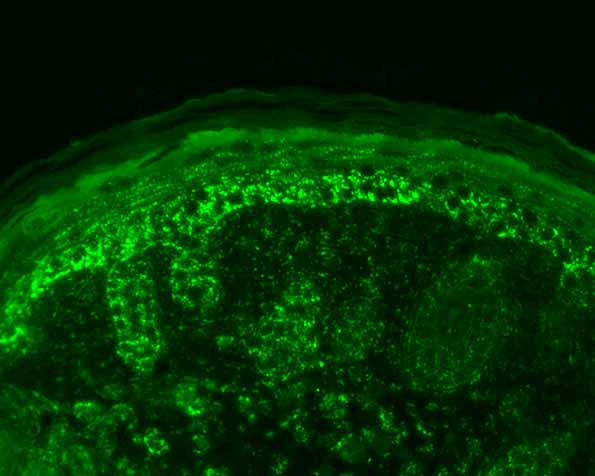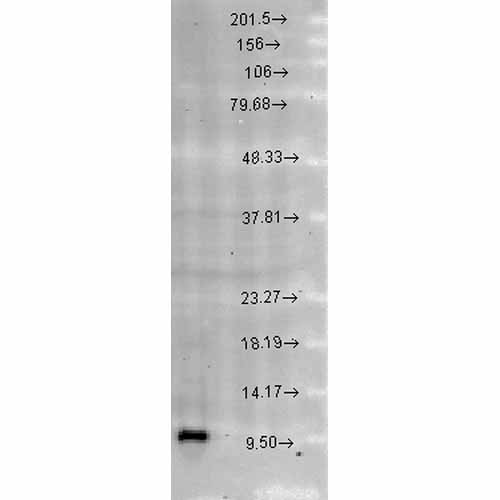Cpn10 Antibody
- SPECIFICATION
- CITATIONS
- PROTOCOLS
- BACKGROUND

Application
| WB, IHC, IP, ICC |
|---|---|
| Primary Accession | P61604 |
| Other Accession | NP_002148.1 |
| Host | Rabbit |
| Reactivity | Human, Mouse, Rat, Rabbit, Pig, Bovine, Xenopus, Dog, Sheep, Guinea Pig |
| Clonality | Polyclonal |
| Description | Rabbit Anti-Human Cpn10 Polyclonal |
| Target/Specificity | Detects ~10kDa |
| Other Names | 10kDa Chaperonin Antibody, Chaperonin 10 Antibody, Cpn 10 Antibody, EPF Antibody, GROES Antibody, Heat Shock 10kD protein1 Antibody, HSP10 Antibody, HSPE1 Antibody |
| Immunogen | Human Cpn10 peptide AA 91-101 |
| Purification | Protein A Purified |
| Storage | -20ºC |
| Storage Buffer | PBS pH7.3, 0.02% sodium azide |
| Shipping Temperature | Blue Ice or 4ºC |
| Certificate of Analysis | 1 µg/ml of SPC-193 was sufficient for detection of Cpn10 in 10 µg of Hela lysates by colorimetric immunoblot analysis using Goat anti-rabbit IgG:HRP as the secondary antibody. |
| Cellular Localization | Mitochondrion | Mitochondrion Matrix |

Thousands of laboratories across the world have published research that depended on the performance of antibodies from Abcepta to advance their research. Check out links to articles that cite our products in major peer-reviewed journals, organized by research category.
info@abcepta.com, and receive a free "I Love Antibodies" mug.
Provided below are standard protocols that you may find useful for product applications.
Background
Chaperonin 10, otherwise known as Cpn10, (groES in E.coli) make up a family of small heart shock proteins with an approximate molecular mass of 10kDa (HSP10s). Cpn10 acts as a co-chaperone and interacts with the HSP60 family to promote proper folding of polypeptides. Cpn10 and Cpn60 both exhibit sevenfold axis of symmetry and function as a team in the protein folding and assembly process (1). Cpn10 has been located in human platelets, but is also present in human maternal serum (2, 3). It has been reported that human Cpn10 is identical with early pregnancy factor, which is involved in control over cell growth and development. This identification suggest that Cpn10 may act like a hormone in stressful situations such as pregnancy (4).
References
1. Velez-Granell C.S., et al. (1994) J of Cell Science. 107(3): 539-549.
2. Morton H., Hegh V., and Clunie G.J.A. (1974) Nature (London) 249: 459-460.
3. Cavanagh A.C., and Morton H. (1994) Eur. J. Biochem. 222: 551-560.
4. Minto M., et al. (1998) Molecular Cell Research. 1403 (2): 151-157.
If you have used an Abcepta product and would like to share how it has performed, please click on the "Submit Review" button and provide the requested information. Our staff will examine and post your review and contact you if needed.
If you have any additional inquiries please email technical services at tech@abcepta.com.













 Foundational characteristics of cancer include proliferation, angiogenesis, migration, evasion of apoptosis, and cellular immortality. Find key markers for these cellular processes and antibodies to detect them.
Foundational characteristics of cancer include proliferation, angiogenesis, migration, evasion of apoptosis, and cellular immortality. Find key markers for these cellular processes and antibodies to detect them. The SUMOplot™ Analysis Program predicts and scores sumoylation sites in your protein. SUMOylation is a post-translational modification involved in various cellular processes, such as nuclear-cytosolic transport, transcriptional regulation, apoptosis, protein stability, response to stress, and progression through the cell cycle.
The SUMOplot™ Analysis Program predicts and scores sumoylation sites in your protein. SUMOylation is a post-translational modification involved in various cellular processes, such as nuclear-cytosolic transport, transcriptional regulation, apoptosis, protein stability, response to stress, and progression through the cell cycle. The Autophagy Receptor Motif Plotter predicts and scores autophagy receptor binding sites in your protein. Identifying proteins connected to this pathway is critical to understanding the role of autophagy in physiological as well as pathological processes such as development, differentiation, neurodegenerative diseases, stress, infection, and cancer.
The Autophagy Receptor Motif Plotter predicts and scores autophagy receptor binding sites in your protein. Identifying proteins connected to this pathway is critical to understanding the role of autophagy in physiological as well as pathological processes such as development, differentiation, neurodegenerative diseases, stress, infection, and cancer.



